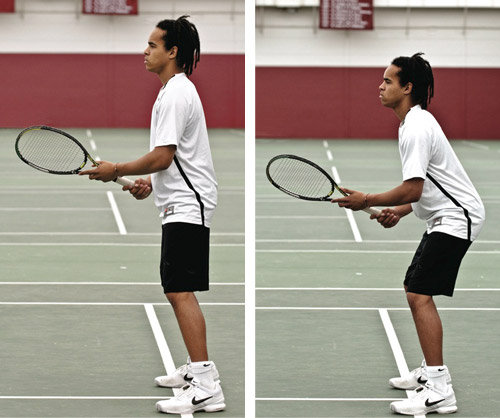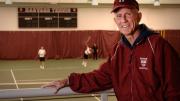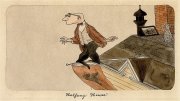In 1970, while watching tennis, Bruce Wright had a life-changing moment. He’d been invited to a professional match in Washington, D.C., that featured the legendary Rod Laver. Wright, an outstanding gymnast at Springfield College, hadn’t seen much tennis, but found himself hypnotized. He observed Laver’s on-court movement with a gymnast’s eyes, ignoring the flight of the tennis ball but soaking up details of how the great Australian lefty carried himself. “I couldn’t even tell you who his opponent was,” Wright says. “But I noticed a subtle thing: Laver had optimized the height of his center of gravity while moving to and from each shot. Later, with much more study, I realized that this was the single factor that distinguished Laver and put him head and shoulders above his peers--not stroke production, not fitness, but his high center of gravity when moving to the ball.”
Wright spent years watching a “huge amount of tennis on videotape” and, through study and experimentation with players, determined that this “high set” (high center of gravity) confers several major advantages. The high set results from “trying to stand as tall as possible,” Wright says, “moving while minimizing flexion of the knees and waist.” Doing so, he says, makes players quicker to the ball, improves their stamina (as it is less fatiguing than a “low set”), and puts less overall strain on the body, making injuries, especially knee injuries, less likely. As a 66-year-old volunteer assistant coach at Harvard, he’s now working with Dave Fish, head men’s tennis coach since 1976, and assistant coach Andrew Rueb to bring this innovative concept to the Crimson varsity.

Photograph by Stu Rosner
Aba Omodele-Lucien ’11 demonstrates a high center of gravity or “high set” (left) and a corresponding “low set.”
Wright’s approach is contrarian because, almost unanimously, tennis coaches advise their students to “get low to the ball,” to move toward the ball from a modified crouch. “If you have to get down to hit the ball,” Fish explains, “the assumption is that you should get down to the ball as early as possible.” But Wright distinguishes crisply between “hitting stance” (one’s stance while actually striking the ball) and “moving stance” (how one holds one’s body while moving around the court between hits). “Nobody has paid any attention to moving stance because everyone is glued to the ball,” he explains. “But the efficiency of your hitting stance is determined by the efficiency of your moving stance. If you get there later, you’ll hit it badly.” Only on the final step before hitting the ball, he advises, should one lower the body to the degree necessary.
The high set enables quicker movement from the “ready” position and keeps athletes light on their feet. The result is the kind of moving stance epitomized in Muhammad Ali’s maxim, “Float like a butterfly.” Wright notes that “Ali was a high setter,” adding that the high set is effective in any sport that involves quick initiation of movement. “It’s very significant, as it affects every single contact with the ball and every recovery after a stroke,” says Fish. “When the player, after the split step [the body’s slight lift that initiates movement], returns to the higher set, that player is instantly unstable in the most desirable sense. That instability allows him to move forward, back up, or lunge out to either side more quickly. [Top professional player Roger] Federer seems to float above the court, because he maintains a high set.”
After his gymnastics career at Springfield College, where he was nationally ranked in the rings (“A physical impossibility for someone as weak as I am,” he says, grinning), Wright went on to coach gymnastics there, and then at MIT and Annapolis, and to consult with the tennis squad at West Point. He took up tennis seriously after his epiphany watching Laver, and within two years was skillful enough to have made the naval academy’s varsity, according to their coach. Using his concept of high set, Wright then worked with several pro tennis players, including Stan Smith, winner of the 1971 U.S. Open and 1972 Wimbledon.
By 1977, Wright felt that he’d introduced the concept of high set to pro tennis, and that its obvious merits would ensure its eventual adoption throughout the game at all levels. Not so. “So great is the force of tradition that the tennis world missed it,” Fish explains. “If you’ve been told that two plus two equals three long enough, no one is going to stick his head out and say it equals four. I had never seen anyone pay attention to the inefficiency of the low set.”
Even a top-10 pro like current American star Andy Roddick could benefit from the high set, Wright says--especially on the forehand side. “Andy lowers to some degree moving to most forehands,” he explains. “Arriving in position in a more crouched, lower moving set than optimal, his body tends to rise up during his forward swing, taking his racquet upward with it. But an upward swing generates topspin, which--in contrast to a flatter ball--reduces pace, producing a less penetrating shot and hence more time for Andy’s opponents to get to and make their reply.”
Wright, who first met Fish almost three decades ago, began sharing his insights with him two years ago, and this year they began coaching the men’s varsity on the importance of high set. “The guys resisted this at the beginning,” Fish says. “It was so contrary to common knowledge--it was like saying, ‘You’re supposed to drive on the left side of the road.’ The high-set concept met with both respectful doubt and mockery and ridicule.” But as players began adopting it, the results started speaking for themselves. “I’ve noticed an increase in consistency, which is the philosopher’s stone of tennis,” says Fish. “Our guys have hit individual shots well enough to beat the pros, except the pros can sustain that kind of play through a match with greater consistency.”
Take Alexei Chijoff-Evans ’11, currently Harvard’s number-one singles player. “Alexei is a big guy who’s been taught to move low all his life,” Fish says. “He felt that his results in tennis all depended on his stroke. After he adopted the high set, he began to feel he could hit a big shot from anywhere on the court.” Chijoff-Evans adds, “I have a propensity to drop my head and bend at the waist too much on the serve. By staying higher, my serve percentage has gone up and I’m able to hit it harder. I’m also making a lot more forehands--not muscling the ball with my arm but hitting it a lot more loosely.”
Wright is now at work on a book titled “The Movement Myth” that describes his findings. He has even gone beyond high set into an analysis of the anterior/posterior axis that he feels can illuminate a long-overlooked physical source of error in athletics. Stay tuned.









